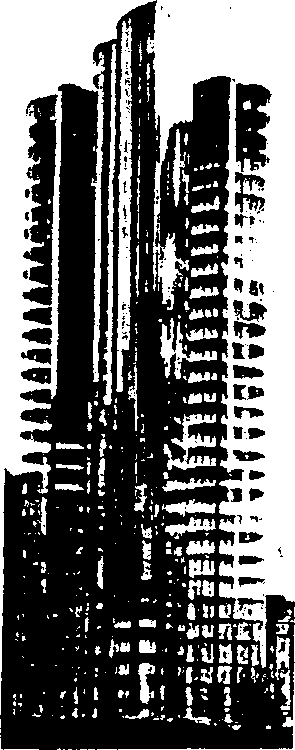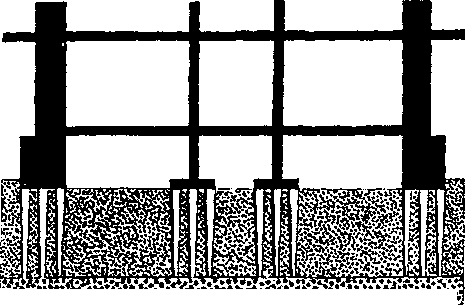
- •Man mast build
- •I. Memorize the following words:
- •Man Must Build
- •II. Answer the following questions.
- •III. Describe the types of foundation works given in the text. Determine what conditions must be considered to choose the right type of foundation works.
- •IV. Are these statements true or false?
- •V. Complete the sentences using an appropriate link.
- •VI. Match the word from column a to its synonym in column b.
- •VII. Translate into English the following word combinations. Use them in the statements of your own.
- •VIII. A) Fill in the gaps with appropriate words.
- •IX. Read the texts again and think of the main problems of these constructions and the engineering solutions to these problems.
- •X. Study some properties of steel and concrete.
- •XI. There are 3 types of building constructions read the decide which paragraph discusses.
- •XII. Say whether these statements are true or false. Correct the false statements.
Man mast build
I. Memorize the following words:
dead weight - статическая нагрузка
live load - динамическая нагрузка
a bearing wall - несущая стена
an enclosing wall - ограждающая стена
a frame - рама, каркас
footing - основание
soft ground - мягкий грунт
firm ground - прочный грунт
a hydraulic jack - гидравлический домкрат
Read the text
Man Must Build
Early builders were at first concerned almost entirely with constructing shelters against rain, cold, wild beasts, and human foes. Later, as their civilizations developed, they built temples, council chambers1, bazaars, and palaces. They took a special delight in erecting pyramids, towers, obelisks, coliseums, and the like.
The story of modern structures is the story of the break from the materials of the past. Great and noble structures were built in brick, timber, and particularly in stone, but now steel and concrete have largely replaced them. With these newer materials we can build to greater heights, span wider gaps, and carry heavier loadings than ever before. In many countries today, mountainous masses of steel and concrete are reaching to the skies on a scale undreamed of in earlier times. Engineers have been able to do this because the rise of the science of structures and the advent of steel and concrete have enabled them to conceive and build their buildings and their structures as frameworks.
Before this, the walls of buildings were "bearing" walls: they carried the dead weight and the live load of the structure. The modern large building, however, is essentially a framework or skeleton of steel or concrete that supports the roof and floors. The outside walls are enclosing or "curtain" walls, and often their weight at each floor is also taken by the framework. So the "sidewalk superintendent,'' gaping curiously at the busy scene on a building site, may see the walls rising simultaneously from the ground and midway between roof and ground. Since the walls do not earn' the structure, they are sometimes made of glass or plastic.
When the lift-slab method was first devised, some people described it as a way of constructing a building from the top downward. The description, however fanciful, draws attention to the novelty of the system. The method does, nevertheless, give an excellent illustration of the framework principle employed in most modern buildings.
One begins by constructing the various floors and the roof on top of one another, and around the columns, at ground level. These are then lifted by powerful hydraulic jacks to their correct positions in the structure, and permanently connected to the columns. In the case of a nine-storey building, the columns may be erected in three stages, and the tops of each stage temporarily braced together by the ascending roof. As the roof and higher floors move upward, they leave behind lower floors which, secured to the columns, serve to brace them permanently together. In this type of structure, therefore, the floors and the roof serve the added purpose of forming part .of the framework. When roof and floors are all finally in place and connected to the columns, the protective walls can be built up from ground level.
In large buildings, the civil engineer's main task is the design of frameworks and foundations.



Left, model by Mies van der Rohe for a glass skyscraper, 1920. Right, Tokyo hotel designed by Frank Lloyd Wright; it rents on a concrete raft (diagram).
Where a building is supported by its walls, the weight is spread out over a large area. This gives relatively low pressures on the ground and makes foundation work easy. But in a modern building framework, the load is carried by a small number of columns, which leads to highly concentrated ground pressure. Hence the foundations must be strong, particularly if the ground is weak.
If the ground is reasonably firm, it is often enough to place the columns on spread footings. These are blocks of concrete of such area as to spread the load to within the carrying strength of the ground. On soft ground, a building is sometimes put on a concrete raft, which is a footing covering the whole ground plan area. A building on its raft is virtually floating on the ground beneath. A method often used is to drive a number of piles under each column foundation. The piles are made long enough to rest on the hard ground below the soft surface. The building is then literally on stilts. Another method is to carry the columns on fairly large diameter cylinders sunk deeply into the ground.
Below, the Empire State Building lowers above :he skyscrapers of New York.

